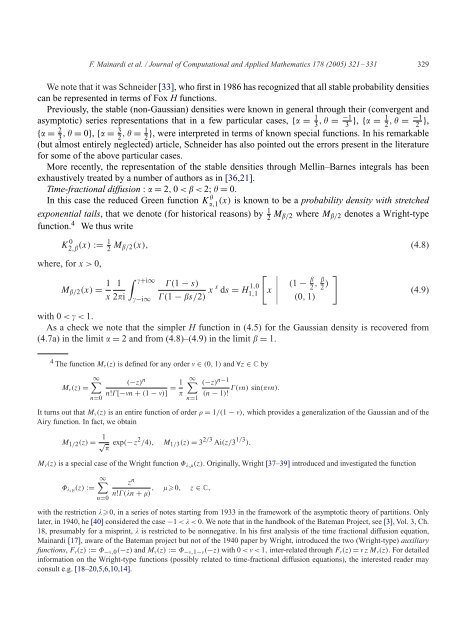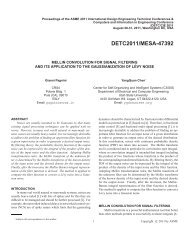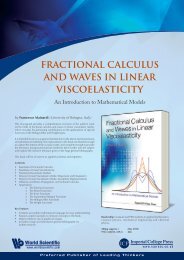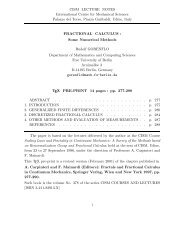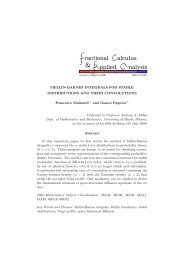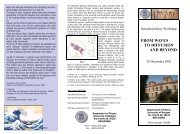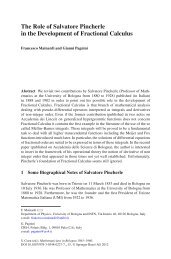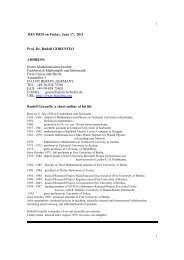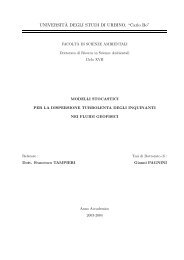Fox H functions in fractional diffusion - FRActional CALculus ...
Fox H functions in fractional diffusion - FRActional CALculus ...
Fox H functions in fractional diffusion - FRActional CALculus ...
You also want an ePaper? Increase the reach of your titles
YUMPU automatically turns print PDFs into web optimized ePapers that Google loves.
F. Ma<strong>in</strong>ardi et al. / Journal of Computational and Applied Mathematics 178 (2005) 321–331 329<br />
We note that it was Schneider [33], who first <strong>in</strong> 1986 has recognized that all stable probability densities<br />
can be represented <strong>in</strong> terms of <strong>Fox</strong> H <strong>functions</strong>.<br />
Previously, the stable (non-Gaussian) densities were known <strong>in</strong> general through their (convergent and<br />
asymptotic) series representations that <strong>in</strong> a few particular cases, { = 1 −1<br />
3 , = 3 }, { = 1 −1<br />
2 , = 2 },<br />
{ = 2 3 , = 0}, { = 3 2 , = 1 2 }, were <strong>in</strong>terpreted <strong>in</strong> terms of known special <strong>functions</strong>.In his remarkable<br />
(but almost entirely neglected) article, Schneider has also po<strong>in</strong>ted out the errors present <strong>in</strong> the literature<br />
for some of the above particular cases.<br />
More recently, the representation of the stable densities through Mell<strong>in</strong>–Barnes <strong>in</strong>tegrals has been<br />
exhaustively treated by a number of authors as <strong>in</strong> [36,21].<br />
Time-<strong>fractional</strong> <strong>diffusion</strong> : = 2, 0 < < 2; = 0.<br />
In this case the reduced Green function K ,1 (x) is known to be a probability density with stretched<br />
exponential tails, that we denote (for historical reasons) by 1 2 M/2 where M/2 denotes a Wright-type<br />
function. 4 We thus write<br />
K 0 2, (x) := 1 2 M/2(x), (4.8)<br />
where, for x>0,<br />
M/2(x) = 1<br />
x<br />
<br />
1 +i∞<br />
2i −i∞<br />
(1 − s)<br />
(1 − s/2) x s ds = H 1,0<br />
<br />
1,1 x<br />
<br />
<br />
<br />
<br />
<br />
(1 − <br />
2 , 2 )<br />
<br />
(0, 1)<br />
with 0 < < 1.<br />
As a check we note that the simpler H function <strong>in</strong> (4.5) for the Gaussian density is recovered from<br />
(4.7a) <strong>in</strong> the limit = 2 and from (4.8)–(4.9) <strong>in</strong> the limit = 1.<br />
4 The function M(z) is def<strong>in</strong>ed for any order ∈ (0, 1) and ∀z ∈ C by<br />
M(z) =<br />
∞<br />
n=0<br />
(−z) n 1<br />
=<br />
n![−n + (1 − )] <br />
∞<br />
n=1<br />
(−z) n−1<br />
(n) s<strong>in</strong>(n).<br />
(n − 1)!<br />
It turns out that M(z) is an entire function of order = 1/(1 − ), which provides a generalization of the Gaussian and of the<br />
Airy function.In fact, we obta<strong>in</strong><br />
M1/2(z) = 1<br />
√ exp(− z<br />
2 /4), M1/3(z) = 3 2/3 Ai(z/3 1/3 ).<br />
M(z) is a special case of the Wright function ,(z).Orig<strong>in</strong>ally, Wright [37–39] <strong>in</strong>troduced and <strong>in</strong>vestigated the function<br />
,(z) :=<br />
∞<br />
n=0<br />
zn , 0, z ∈ C,<br />
n!(n + )<br />
with the restriction 0, <strong>in</strong> a series of notes start<strong>in</strong>g from 1933 <strong>in</strong> the framework of the asymptotic theory of partitions.Only<br />
later, <strong>in</strong> 1940, he [40] considered the case −1 < < 0. We note that <strong>in</strong> the handbook of the Bateman Project, see [3], Vol.3, Ch.<br />
18, presumably for a mispr<strong>in</strong>t, is restricted to be nonnegative.In his first analysis of the time <strong>fractional</strong> <strong>diffusion</strong> equation,<br />
Ma<strong>in</strong>ardi [17], aware of the Bateman project but not of the 1940 paper by Wright, <strong>in</strong>troduced the two (Wright-type) auxiliary<br />
<strong>functions</strong>, F(z) := −,0(−z) and M(z) := −,1−(−z) with 0 < < 1, <strong>in</strong>ter-related through F(z) = zM(z). For detailed<br />
<strong>in</strong>formation on the Wright-type <strong>functions</strong> (possibly related to time-<strong>fractional</strong> <strong>diffusion</strong> equations), the <strong>in</strong>terested reader may<br />
consult e.g. [18–20,5,6,10,14].<br />
(4.9)


